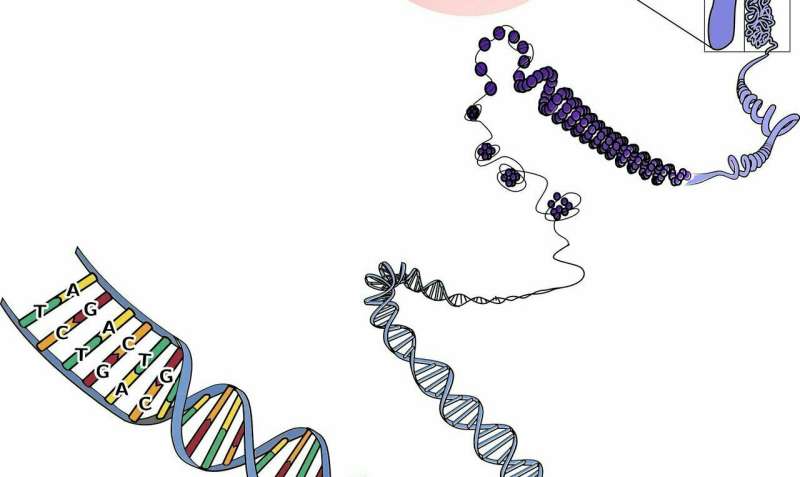A new strategy for siRNA stabilization by an artificial cationic oligosaccharide

RNA interference is a gene regulatory mechanism in which the expression of specific genes is downregulated by endogenous microRNAs or by small interfering RNAs (siRNAs). Although siRNAs have broad potential for gene-silencing therapy, their instability is one of the difficulties in developing siRNA-based agents. To improve their stability, most of the developed siRNA-based drugs are chemically modified in their nucleotides or phosphodiester linkages. However, chemical modification is not a perfect strategy for siRNA stabilization because extensive modification may interrupt the gene-silencing activity of siRNAs and also induce cytotoxicity.
siRNAs consist of oligonucleotide duplexes of 21-23 bases and form an A-form helix structure in which the major grooves have highly negative potential, therefore cationic molecules that can bind to the major grooves are expected to stabilize the RNA duplexes and protect them against cleavage in the body fluid. Based on this idea, organic chemists at Tokyo University of Science have recently synthesized an artificial cationic oligosaccharide, oligodiaminogalactose 4mer (ODAGal4), that can preferentially bind to the major grooves of RNA duplexes for siRNA stabilization.
Now, Atsushi Irie and his colleague at Tokyo Metropolitan Institute of Medical Science in collaboration with the team at Tokyo University of Science have developed a new strategy for siRNA stabilization using ODAGal4 combined with phosphorothioate modification of RNAs. In the study published online on 9th September in the Scientific Reports, the researchers have proved that ODAGal4 strongly enhances biological and thermal stability of siRNAs in vitro.
The researchers show that ODAGal4 has several unique characteristics for stabilizing siRNAs. Firstly, ODAGal4 can improve stability of various siRNAs independent of nucleotide sequence because ODAGal4 binds to phosphodiester linkages of RNA duplexes but not to nucleobases of the nucleotides. In addition, importantly, ODAGal4 does not compromise gene-silencing activity of any siRNAs. This character of ODAGal4 is in sharp contrast to those of known chemical modifications, which may interrupt gene-silencing activity of siRNAs. ODAGal4, therefore, has great potential for siRNA stabilization, being widely applicable to various siRNA-based drugs.
Secondly, the effect of ODAGal4 on siRNA stabilization is further enhanced by chemical modification of the siRNAs; in particularly, ODAGal4 prominently improves stability of RNAs with phosphorothioate linkages. This improvement in siRNA stability is superior to that observed for other chemical modifications (e.g., 2'-O-methyl, locked nucleic acid and 2'-deoxy-2'-fluoro nucleotides) suggesting that ODAGal4 combined with phosphorothioate modification is highly effective for stabilizing siRNAs.
Lastly, another striking property of ODAGal4 is its binding specificity to RNA duplexes; ODAGal4 binds to A-form RNA helix but not to B-form DNA helix nor to single-stranded RNA/DNA. Although various gene delivery systems consisting of cationic polymers have been developed to stabilize nucleotides, the molecular structures of the polymers are not designed to specifically bind to nucleotides. The binding of the polymers to nucleotides relies on the ionic interaction between them, and thereby the polycation complexes are prone to induce cytotoxicity due to nonspecific binding of the polymers to other biomolecules. In marked contrast, ODAGal4 escapes from causing cytotoxicity because of its restricted binding with high affinity to RNA duplexes.
"Our goal will be application of ODAGal4 for siRNA-based agents. Although we should study in vivo experiments to confirm and expand our findings, we emphasize that ODAGal4 has a great advantage as improving siRNA stability and has a potential for reducing total dose and frequency of administration of siRNA-based drugs in future application," concludes Atsushi Irie.
More information: Atsushi Irie et al, An artificial cationic oligosaccharide combined with phosphorothioate linkages strongly improves siRNA stability, Scientific Reports (2020). DOI: 10.1038/s41598-020-71896-w
Journal information: Scientific Reports
Provided by Tokyo Metropolitan Institute of Medical Science



















